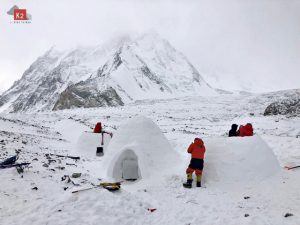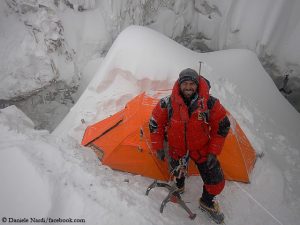Coster: “Too busy in the Khumbu Icefall“
The Everest spring season is on. This Saturday, eight “Icefall Doctors“ will be celebrating a puja in the base camp on the Nepalese south side of the highest mountain in the world, a Buddhist ceremony, during which the gods are asked for their blessing. Next week, the Sherpas, who are specialized in this task, will prepare this year’s route through the Khumbu Icefall. At the beginning of April the first commercial teams are expected in the base camp. “I’m wondering how busy it will be on the south side with every year we see the numbers increasing significantly,“ says Arnold Coster, when I meet him today in Kathmandu. “And I wonder how many actually switch to the Tibetan side.“
Only one new operator in Tibet
In truth, only the expedition operator Altitude Junkies of the British Phil Crampton has been added, says Arnold: “It sounds in the media as if a lot of people are switching but I think most of the regular companies will be there, but with bigger groups – including myself.“ The 41-year-old Dutchman will lead an internationally mixed team of twelve clients. Already last year, Arnold was en route on the Tibetan north side. “The main reason why I climb in Tibet is that it’s too busy in the Icefall on the South side. There are too many people who are too slow and it’s easy to get stuck in a traffic jam.“ Moreover, the objective dangers on the north side are much lower, says Coster, adding that after heavy snow fall, there is only, if at all, a low avalanche danger on the way up to the 7,000-meter-high North Col. “On the south side, however, you are constantly in danger in the Icefall, but also in in the Western Cwm by avalanches if there is a lot of snow. And even in the Lhotse Face.“
Three times on the summit
Coster has been living in Nepal since 2004. He is married to Maya Sherpa, one of the country’s most famous female climbers (my interview with her will follow later). They have a daughter aged seven. This spring, Arnold will lead his 15th Everest expedition. He has been on the summit at 8,850 meters three times – more than any other mountaineer from the Netherlands. “My job is taking care of the people and not going to the summit myself,“ says Arnold, pointing out that he has been already eight times on the 8,748-meter high South Summit of Everest. “Very often I climb with my group but I turn around with somebody who needs help.“ In spring 2016, however, any help came too late for two of his clients. Within 24 hours, a Dutchman with whom Coster was a friend and an Australian woman died – even though both had reached the South Col after their summit attempt. In social networks, Arnold was subsequently accused of not informing the families of the deceased in time.
Liaison officer passed on sensitive information
“That is not the truth. The truth is that I got an emergency contact for all of my members. So as soon as I called this emergency contact, and I did that, I felt that my part of the job was done. And they should spread the news between friends and family. That part didn’t happen, but I got accused of that,“ says Coster. “At this point I was busy on the mountain with the rescue of other team members and with the recovering of the victims.“ According to Arnold, the liaison officer in the base camp was responsible for the fact that the families learned about the death of their relatives from the internet. The officer had nothing better to do than to reveal internal information from the radio in an interview, says Arnold.
“Quite silly“
Coster does not favour the new rules for expeditions in Nepal. As reported, the government had decided not to grant permits to double amputees and blind climbers and to prohibit solo climbs. Meanwhile Nepal’s Supreme Court overruled the permit ban for disabled climbers. “The rules are quite silly because those people don’t cause the problems on Everest,“ says Arnold. “The big problem on the south side are unexperienced people.“ It would make much more sense, finds Coster, to demand for example from Everest aspirants to have climbed previously at least a seven-thousander in Nepal: “Then you can check it because the records are in the (Tourism) Ministry. And you also don’t lose the income, because tourism is one of the biggest sources of income in Nepal.“
The main reason that proposals like this come to nothing is that the Nepalese government has changed every six to eight months since the end of the monarchy in 2008, says Coster: “There is a new government now and people hope for – and I also hope – that this government is gonna stay the full term. It doesn’t even matter who is there. As long as people stay, we’re gonna make a plan. But if people are always changing, how can we make a plan?“
P.S. You may be wondering why I am currently visiting Nepal. Tomorrow, in Thulosirubari, 70 kilometers east of Kathmandu, the first two buildings of the new school will be inaugurated, which could be built with your donations for our aid project “School up!“. In addition, German climber Ralf Dujmovits and I will lay the foundation for the second construction phase. Then I will report on the celebration in the small mountain village. In addition, I use the opportunity to conduct some interviews on the upcoming climbing season in the Nepalese capital. I will publish these interviews by and by in the blog.












